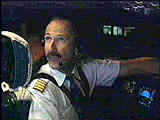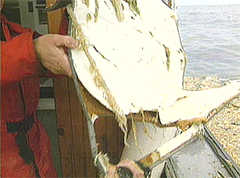Canada Calls For Higher Flammability Standards In Swissair 111 Aftermath
By Sean Broderick/AviationNow.com
28-Aug-2001 2:59 PM U.S. EDT
Canada's safety board says new, more stringent flammability standards are needed for materials used in aircraft construction, and new wire certification requirements should be developed that will help limit the chances that damaged wires will become ignition sources.
The two recommendations, part of a three-pronged package issued Tuesday, are the latest safety initiatives to come out of the Transportation Safety Board's (TSB) probe of Swissair 111. TSB also called on regulators and aircraft manufacturers to ensure that systems in the pressurized part of a plane won't make a fire worse if any parts contained in them fail.
Enhancing aircraft material flammability standards isn't a new concept,
but TSB believes it needs to be broadened considerably. Current regulations
take into consideration where a material will be on the airplane, calling
for higher levels of flame resistance for structures - such as cabin walls
and seat cushions - that passengers come in contact with regularly. TSB
believes similarly high standards should apply to material in "hidden,
remote, or inaccessible" areas, or else fires that start in out-of-the-way
places on a plane will be more likely to yield catastrophic results.

Current flammability standards also fall short because they don't consider ancillary factors beyond how long flames burn or how fast they spread. Factors such as how hot burning material gets, how much smoke it gives off, or the type of toxins it releases should also be considered, because these problems can be just as devastating as flames.
"As these flammability characteristics are by-products of the combustion process, the board believes that the most effective means to mitigate these additional threats is to eliminate the use of all materials that sustain or propagate fire," TSB says in its recommendation letter.
Regarding wiring, TSB acknowledged that the increased attention to wire damage on aircraft - kicked into high gear during the investigations of the July 1996 TWA 800 in-flight explosion and the Swissair 111 accident - will likely yield positive long-term results. But, TSB argued, developing improved design, maintenance and inspection practices so that wire system damage is either limited from the outset or discovered and eliminated before it creates problems will take some time.
To support such efforts, industry must gain a better understanding of how wires fail, and create certification standards that test wire failure characteristics. Existing rules test wire's passive role in fires, measuring how it reacts to flames as if it is just another piece of material the might get in a fire's way. Industry must view damaged wire as a potentially active participant in fires, and establish certification standards that seek to "mitigate the risk of ignition," TSB says.
"Understanding the dynamics of how a wire will fail under realistic conditions would be valuable, given the known consequences of the failure of an energized wire," TSB says. "While the [U.S. Federal Aviation Administration, or FAA] endorses several failure tests...it does not require any failure tests as a basis for wire certification."
FAA, in its recently released Enhanced Airworthiness Program for Airplane Systems, said it planned to look at new certification standards for aircraft wiring. The U.S. agency stopped short of making the upgraded standards a part of the plan, however.
TSB's third recommendation deals with parts of larger systems that aren't held to strict flammability standards. For example, the board found that "endcaps" on the MD-11 oxygen and air conditioning systems "have exhibited less-than-ideal fire propagation characteristics." Should an oxygen system cap rupture during a fire, the resulting discharge of oxygen into the flames could make the situation worse, TSB says.
Certification requirements call for systems safety analysis to determine what effect a part's failure would have on a plane's ability to fly and land safely, but they don't call for fire to be introduced as a variable. And while parts that will be located in designated aircraft "fire zones" - like engines - must meet more stringent standards, TSB believes applying the higher standards to all areas of aircraft will add an invaluable level of safety.
"In most other areas of the aircraft, there is no requirement to
determine if a material's failure would exacerbate a fire in progress," TSB
points out. "Yet the selection of inappropriate materials may lead to
premature breaches of certain systems such as oxygen, hydraulic, wiring, and
air environmental which could exacerbate an in-flight fire."

Swissair 111, an MD-11, crashed into the Atlantic Ocean near Halifax, Nova Scotia, on Sept. 2, 1998. The pilots declared an emergency after detecting signs of an in-flight fire, but the spreading flames crippled the plane's systems and instruments before the crew could get the MD-11 down safely. Investigators have not determined how the fire started, but they know it happened somewhere outside the plane's high-traffic areas - in other words, in a place where it could steadily grow worse without being detected.
In the last three years, regulators and safety experts - led by TSB and Swissair - have worked to examine existing standards regarding several factors that played roles in the accident, including wiring safety, flammability, and in-flight emergency procedures.
"Our purpose in issuing these recommendations now is to enhance the safety of the traveling public as quickly as possible, as we have done on previous occasions during this lengthy investigation," TSB Chairperson Benoît Bouchard told reporters Tuesday in Ottawa. "We want everyone to know about potential safety deficiencies as soon as we learn about them, so that public safety is not compromised while we continue our work to evaluate what happened to Swissair Flight 111."
Tuesday's recommendations are the third set issued by TSB as a result of the probe. The others addressed flight recorder duration and power supply, insulation properties, and in-flight firefighting. Other outcroppings from the probe include a comprehensive effort by Swissair to upgrade systems safety on its MD-11s, and a number of non-structural systems-related FAA airworthiness directives on MD-11s and other jets.
See Also:
TSB Flammability Standards Recommendations (Aug. 2001)
TSB Firefighting Recommendations (Dec. 2000)
TSB Insulation Recommendations (Aug. 1999)
TSB Flight Recorder Recommendations (March 1999)
Swissair 111
Investigation (Click Swissair 111 On Menu At Left)
FAA Enhanced
Airworthiness Program For Airplane Systems (.doc)